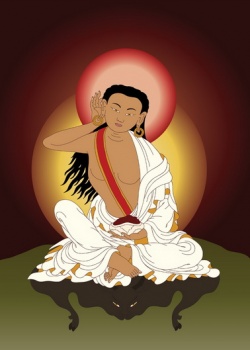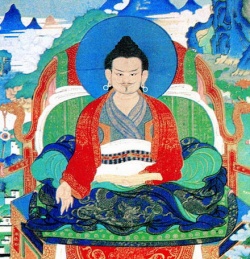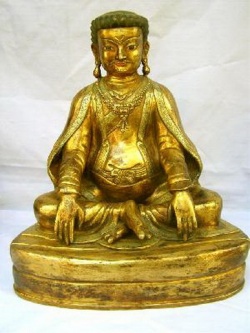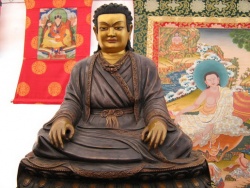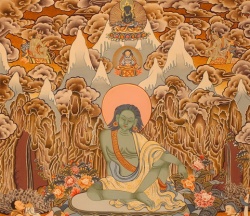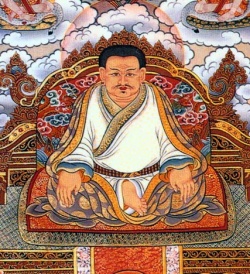The Lesson of the Guru
The Lesson of the Guru:
What was Marpa trying to teach Milarepa?
Published in Buddhism Now (August 96)
© 1991 by W. Teed Rockwell
One of the most famous Dharma stories in Tibetan Buddhism is the life of the twelve century Yogi Milarepa, and perhaps the most quoted part is the story of the ordeal that his guru, Marpa, put him through before he accepted him as a student. The most recently published (and reputedly most accurate) version of this story is The Life of Milarepa translated by Lobsang P. Lhalungpa (Shambala 1977), which is the source for the following summary and most of the following quotes. When Milarepa's father died, his will specified that Milarepa's aunt and uncle were to manage his property until Milarepa became of age, at which point he was to receive all of his father's property.
However, when the time came for Milarepa to inherit, his aunt and uncle refused to give him anything and turned him and his mother and sister out of the house. At his mother's urging, however, he learned black magic and eventually used it to take revenge on his uncle's family. He created a scorpion the size of a yak which destroyed his uncle's stable, called up demons that killed all of his uncle's guests at a party, and eventually produced a hailstorm that destroyed all of the crops in the surrounding village. Horrified by the possibility of an eternity in the hell-realms because of the negative karma he had accumulated, he went to the great yogi Marpa and asked him for teachings.
Marpa recognized through various signs that he and Milarepa had a strong karmic connection and that Milarepa would eventually become his greatest student. But he did not give any indication of this to Milarepa. On the contrary, he proceeded to give him a series of exhausting and seemingly irrelevant tasks to do, and when Milarepa asked for the teachings he would abuse Milarepa verbally and physically. The most famous of these tasks was the building of four towers, each of which Marpa demanded be torn down after it was finished. Milarepa's back became so covered with sores from carrying stones that he became extremely ill. Eventually Marpa's wife Dagmema felt so much compassion for Milarepa that she devised a scheme for him to get teachings without Marpa's knowledge. She took some sacred jewels from Marpa's room and forged a letter instructing one of Marpa's disciples to give Milarepa teachings.
But the teachings were ineffective when obtained under false premises, and eventually Marpa called Milarepa back. Marpa then told Milarepa that he had always had every intention of accepting Milarepa as a student, and that the ordeals Milarepa had gone through were a necessary preliminary to the secret teachings he had now shown himself worthy to receive. The question I want to ask here is "what was the lesson that Marpa was trying to teach Milarepa?"
The usual interpretation of this story is that Marpa wanted to teach the importance of total obedience to the guru: that one must obey the commands given by the guru no matter how difficult or incomprehensible, because this unconditional obedience is the primary thing that makes the transmission of enlightenment 3 possible. Milarepa was thus ready to receive the teachings only when he had proven that he would obey any command given to him. This interpretation of the story is helpful in strengthening the resolve of students who are questioning their gurus and losing the willpower to stay on their spiritual path. There is no question that obedience to a guru is a powerful spiritual device, and is one of the things that makes Vajrayana techniques so powerful for transforming consciousness. It is also unquestionably an important factor in the teachings of the lineage that descends from Marpa and Milarepa through the Karmapa and up to the teachers in the Kagyu lineage to this day. Kalu Rinpoche has stressed that "To view the teacher as an ordinary person and become critical does not help us and in fact can be a serious obstacle." (Kalu, p. 69).
In a Dharma talk given in San Francisco in 1985, he cited this story as an example of the importance of obedience to one’s guru. Chogyam Trungpa, who was an incarnate lama in the Kagyu lineage, also cites this story as a lesson in obedience in Cutting through Spiritual Materialism, summing up the lesson of the story by saying that "The process of receiving the teachings depends upon. . . some kind of psychological surrender" (Trungpa p.39) If this interpretation of the story helps students develop a strong bond with their guru, then it has performed a useful spiritual service. But I think that a close reading of the text (Lhalungpa 1977) gives strong indications that this might not actually be what Marpa was trying to do in this particular case.
There is of course no way of knowing for certain the correctness of any interpretation of a story we now know only through folk tales and scriptures. I do not claim that my re-interpretation can be shown to be the only possible one. But I think it can be seen as fitting the facts every bit as accurately as the traditional interpretation described above. My interpretation of Marpa's strategy is this: Marpa was not trying to teach Milarepa to surrender, he was trying to teach Milarepa to rebel. Once Milarepa had disobeyed Marpa, he was in the right state of mind to receive the teachings, and that was why he began teaching him at that time. It may seem contrary to the principles of Guru Yoga to question the interpretation of this story which has been repeated and confirmed by hundreds of years of Tibetan scholarship. But my interpretation is in many ways more respectful of Guru Marpa than is the traditional one.
According to the traditional interpretation of the story, Marpa was forced to reveal his strategy a little too early because of the meddling of his wife Dagmema. As Lhalungpa says in his introduction "The ordeals are hastily ended and much against the plan, Marpa grants Milarepa the teachings" (p. xii) According to my interpretation, Dagmema's "meddling" helped Marpa to produce the result he had been trying to achieve all along. Marpa would therefore have been working to some degree in collaboration with Dagmema, and not at cross purposes with her. 4 With all the talk we hear about the importance of obedience to a guru, it seems strange to talk about a Guru demanding disobedience.
But we must remember that Milarepa was no ordinary student. When he met Marpa he was already an extremely gifted magician, and he had obviously learned these powers by careful obedient study with a guru. And more importantly, it seems that the murderous acts of magic which caused him so much karmic trouble were done primarily because he was too obedient to his mother. Although Milarepa was obviously filled with sorrow because of losing his inheritance, there is no mention in the text of Milarepa himself harboring thoughts of revenge or anger. The only thing he says about his mental state at that time was, "suffering from hunger, our clothes in rags and tatters, we were not happy" (p.21).
Note that he says “we were not happy,” not “I was not happy.” He makes no mention of harboring some deep internal passion that would drive him to revenge. On the contrary, there are indications that Milarepa would have been willing to let go of his sorrow if left to himself. When Milarepa's students ask him "Master, what circumstances led you to cast spells and cause hailstorms?," the story he tells in reply seems to indicate that if it weren't for his mother, he probably would have accepted his misfortune as typical of samsaric existence. He says that his mother heard him singing to himself after having drunk some beer at a party for his tutor, and her reaction was "How could he be singing when we are so miserable?"(p.22).
She then threw ashes in his face, hit him several times, and continued to berate him until he too felt the wretchedness of their condition. He then told her that he would do whatever she wished. She demanded that he go and study magic so that he could take revenge and added "if you return without having shown signs of your magic in our village I, your old mother, will kill myself before your eyes" (p.24). It is obvious from this story if he had been less obedient and more willing to think for himself, he probably would have realized that their happiness would have been better served by letting go of the past and seeking happiness, not revenge. But because he was an obedient son he became the dutiful servant of his mother's fury, and thus acquired the negative karma that made it necessary for him to seek out Marpa's teachings. It thus seems plausible to interpret Marpa's commands to Milarepa as attempts to make him rebel against or question Marpa; to teach him that unthinking obedience was what he needed to overcome in himself. The first thing Marpa asks Milarepa to do is the very thing that got Milarepa into trouble in the first place: to create a hailstorm which will destroy the crops of some of Marpa's enemies. Milarepa, as pathologically obedient as ever, creates the hailstorm and so accumulates more bad Karma for himself. 5
Marpa rebukes him angrily for asking for the teachings in exchange for this (even though he had said he would give them), and tells him to destroy some more of Marpa's enemies who live in the nearby mountains. When Milarepa obeys him yet again, and asks for the teachings, Marpa says "Is it to reward your many crimes that I went to India? [to get teachings]... Restore the harvest...and heal the mountaineers; after that I will teach you." (p.48). Perhaps he was trying to show him that a crime is a crime, even if it is done in obedience to a guru or a vengeful mother. After that Marpa told Milarepa to construct a tower for him, and did everything he could to make himself appear as untrustworthy as possible. Not only were his instructions difficult and exhausting, they were given in manner that made Marpa himself seem capricious and unreliable. Four times he told Milarepa to tear the tower down and rebuild it. The first time he said he had not fully considered the matter, the second time he said that he must have been drunk, the third time he said that he must have lost his mind (p.51) As a result, Milarepa became less servile and more willing to stick up for himself.
At one point he says "To tear something down while it is being built makes me miserable and is a waste of your wealth. Please think carefully before hand."(p.49) He insists that Marpa's wife Dagmema witness their agreement for the fourth attempt at building a tower, so that Marpa cannot change his instructions later. However, when two of Marpa’s other students place a rock in one corner of the tower’s foundation, Marpa says that Milarepa must remove that stone, because “it is not fitting for you to be served by my disciples who are practicing the two advanced stages. Do not demolish everything, but take away the stone and put it where it was” (p. 51). But, of course, it was impossible to remove a foundation stone without destroying the entire tower, so once again Milarepa’s work was for nothing. After Milarepa had carted the offending stone away, Marpa made him put it back, and rebuild the entire tower exactly as it was. Even after Milarepa had finally finished the tower, Marpa still refused to keep his side of the bargain, demanding additional gifts in return. At this point, I claim that Milarepa realized that total obedience was not going to get him the teachings, and that if Marpa was going to trick him he could trick Marpa in return. Consequently, he followed a scheme devised by Dagmema, in which she forged Marpa’s name on a letter asking Ngokpa, one of Marpa’s disciples, to instruct Milarepa.
When Ngokpa accepts Milarepa as a disciple, he tells Milarepa to destroy two local villages with hail. This time, however, he obeys only partially, and alters the commands to save a life. When an old woman cries out “my crops will be destroyed by hail. What will I have to eat ?,” he says to himself “what I am doing is criminal,” (p.63), and arranges to create an area exactly the size of her field where the hail does not fall. Finally he is beginning to learn to temper obedience with compassion. 6 When Milarepa is called back by Marpa, and Marpa reveals that he had planned to give him the teachings all along, Marpa becomes angry at Dagmema (she locks herself in the temple to avoid being beaten.), but at no time does he criticize Milarepa for his actions. On the contrary, he says “[[[Milarepa]]) was burning with desire for religion, and was right to use any means to obtain it.” (p. 72)
It seems likely to me that Marpa would have preferred Milarepa to have disobeyed him without participating in theft and forgery. I think he also would have preferred for Milarepa to have disobeyed him without being urged by somebody else, for this would have made him more self-reliant and less easy to manipulate. To some degree, Milarepa had merely shown that he could be obedient to Dagmema instead of Marpa, and had still not genuinely learned how to think for himself. That would explain why Marpa became angry at Dagmema when he discovered what she had done. But I also think Marpa was resourceful enough to work with the circumstances that Dagmema had created, and probably realized that her contribution to his enlightenment was essential.
He does say that ‘due to Dagmema’s weakness... there will be a faint stain of defilement with him” (p. 72). But he also says that her actions are what will keep Milarepa from “complete enlightenment without future rebirth” In other words, this “defilement” is what keeps Milarepa from permanently entering Nirvana, and consequently he stays near to the sentient beings who need him in their striving for enlightenment. Dagmema’s compassion thus appears to be responsible for Milarepa’s remaining as a boddhisatva. Once Marpa and Milarepa begin working together, Milarepa is certainly diligent and respectful. But it is also clear that he has finally learned to think for himself when necessary. Before he started receiving teachings, he obeyed all of Marpa's ridiculous and contradictory commands to the letter. After he starts receiving teachings, he frequently alters Marpa's commands slightly, and Marpa praises him for doing so.
For example, about a year after Milarepa had been accepted as a disciple, Milarepa received a vision from a Dakini, and broke down the wall of his cell to tell Marpa about it. Even though Marpa says to him "Why have you come out of strict seclusion. This could hinder your progress. Why have you done it?" (p.80), Milarepa does not slink back into his cave, but stands his ground and tells Marpa about his vision. If the tower building ordeal was designed to teach Milarepa total obedience, it obviously failed. Another time, Milarepa has a dream in which he sees (correctly) that his family was scattered and his ancestral home was in ruins. Once again he breaks out of his seclusion, and once again Marpa tells him to return to his meditation. And this time when he says that he is going to go try to find his family, Marpa tells him that he thinks this is a bad idea but that "if you wish to leave, I will let you go." (p.90). Marpa is in effect admitting that Milarepa, at this stage in his development must be permitted to do what he thinks is best, even if Marpa can not understand his reasons.
When Milarepa does leave, we once again see Marpa's awareness of Milarepa's tendency to selfdenial. Marpa gives Milarepa a scroll before he first went out to meditate in solitude. He tells Milarepa that 7 if he ever gets hopelessly blocked in his progress towards enlightenment, he should open the scroll. One time when Milarepa is starving in a cave and on the brink of despair, he opens the scroll. In it is not only instructions for further practices, but also ‘The advice to take good food at this time." (p.127)
Marpa knew that his pupil's greatest obstacle was his willingness to sacrifice everything once he had set a goal for himself, and that consequently there was no need to urge him to more rigorous self-discipline. Obstacles that could be conquered with self-discipline Milarepa would meet head on and vanquish. What he was not good at was looking out for his own needs, and so Marpa knew that what he would need to hear when he was stuck was an admonition to relax and get something to eat. Perhaps the passage that shows Milarepa’s greatest transformation is the following, said when he was leaving Marpa to search for his lost family: “I need never be separated from my lama, as long as I can visualize him in meditation above the crown of my head” (p.100).
Milarepa had developed his inner sense of the truth so fully that he no longer needed to receive instructions from a flesh and blood lama. Indeed, the text says that he never saw his lama again. Nevertheless, he went on to become one of Tibet’s greatest spiritual masters, with no guide but his own inner sense. There is no denying that my interpretation is open to question. It could have been that Marpa kept Milarepa working on the towers because he was not yet fully obedient, and the quotes I cited to indicate his progress might actually have been indications of traits he still needed to overcome. The text also seems to indicate that Marpa might have forced Milarepa to undergo these ordeals to create the emotions of repentance necessary to cleanse his Karma. (p.74) Someone not sympathetic to Buddhism might interpret the story by saying that Marpa was simply exploiting Milarepa in order to get some cheap labor out of him before giving him the teachings. The only question that really matters now is “what interpretations are most useful to those who practice the Dharma?”
Many spiritual teachers claim that we in the west are not as good at obedience as are eastern practitioners. But it is possible that our incompetence at obedience may cause us to err in both extremes, and if so, both interpretations of the story would be relevant to our condition. I know of no example of pathological obedience in Asian history as extreme as the Jonestown massacre. Perhaps we, even more than Milarepa, need to learn how to temper our obedience with wisdom and compassion. Bibliography Kalu Rinpoche, (1986) The Gem Ornament of Manifold Oral Instructions (which benefits each and everyone appropriately) San Francisco KDK press Lhalungpa, Lobsang P. (1977) The Life of Milarepa Boston Shambala 8 Trungpa, Chogyam (1970) Cutting through Spiritual Materialism Boston Shambala
